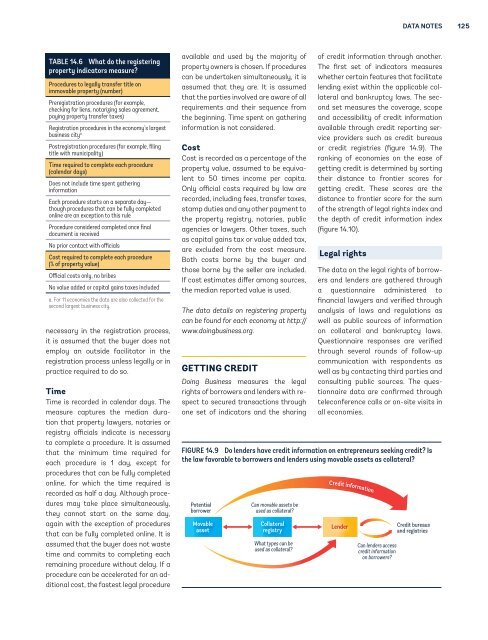bc8G2-7
bc8G2-7
bc8G2-7
Create successful ePaper yourself
Turn your PDF publications into a flip-book with our unique Google optimized e-Paper software.
Data Notes<br />
125<br />
TABLE 14.6 What do the registering<br />
property indicators measure?<br />
Procedures to legally transfer title on<br />
immovable property (number)<br />
Preregistration procedures (for example,<br />
checking for liens, notarizing sales agreement,<br />
paying property transfer taxes)<br />
Registration procedures in the economy’s largest<br />
business city a<br />
Postregistration procedures (for example, filing<br />
title with municipality)<br />
Time required to complete each procedure<br />
(calendar days)<br />
Does not include time spent gathering<br />
information<br />
Each procedure starts on a separate day—<br />
though procedures that can be fully completed<br />
online are an exception to this rule<br />
Procedure considered completed once final<br />
document is received<br />
No prior contact with officials<br />
Cost required to complete each procedure<br />
(% of property value)<br />
Official costs only, no bribes<br />
No value added or capital gains taxes included<br />
a. For 11 economies the data are also collected for the<br />
second largest business city.<br />
necessary in the registration process,<br />
it is assumed that the buyer does not<br />
employ an outside facilitator in the<br />
registration process unless legally or in<br />
practice required to do so.<br />
Time<br />
Time is recorded in calendar days. The<br />
measure captures the median duration<br />
that property lawyers, notaries or<br />
registry officials indicate is necessary<br />
to complete a procedure. It is assumed<br />
that the minimum time required for<br />
each procedure is 1 day, except for<br />
procedures that can be fully completed<br />
online, for which the time required is<br />
recorded as half a day. Although procedures<br />
may take place simultaneously,<br />
they cannot start on the same day,<br />
again with the exception of procedures<br />
that can be fully completed online. It is<br />
assumed that the buyer does not waste<br />
time and commits to completing each<br />
remaining procedure without delay. If a<br />
procedure can be accelerated for an additional<br />
cost, the fastest legal procedure<br />
available and used by the majority of<br />
property owners is chosen. If procedures<br />
can be undertaken simultaneously, it is<br />
assumed that they are. It is assumed<br />
that the parties involved are aware of all<br />
requirements and their sequence from<br />
the beginning. Time spent on gathering<br />
information is not considered.<br />
Cost<br />
Cost is recorded as a percentage of the<br />
property value, assumed to be equivalent<br />
to 50 times income per capita.<br />
Only official costs required by law are<br />
recorded, including fees, transfer taxes,<br />
stamp duties and any other payment to<br />
the property registry, notaries, public<br />
agencies or lawyers. Other taxes, such<br />
as capital gains tax or value added tax,<br />
are excluded from the cost measure.<br />
Both costs borne by the buyer and<br />
those borne by the seller are included.<br />
If cost estimates differ among sources,<br />
the median reported value is used.<br />
The data details on registering property<br />
can be found for each economy at http://<br />
www.doingbusiness.org.<br />
GETTING CREDIT<br />
Doing Business measures the legal<br />
rights of borrowers and lenders with respect<br />
to secured transactions through<br />
one set of indicators and the sharing<br />
of credit information through another.<br />
The first set of indicators measures<br />
whether certain features that facilitate<br />
lending exist within the applicable collateral<br />
and bankruptcy laws. The second<br />
set measures the coverage, scope<br />
and accessibility of credit information<br />
available through credit reporting service<br />
providers such as credit bureaus<br />
or credit registries (figure 14.9). The<br />
ranking of economies on the ease of<br />
getting credit is determined by sorting<br />
their distance to frontier scores for<br />
getting credit. These scores are the<br />
distance to frontier score for the sum<br />
of the strength of legal rights index and<br />
the depth of credit information index<br />
(figure 14.10).<br />
Legal rights<br />
The data on the legal rights of borrowers<br />
and lenders are gathered through<br />
a questionnaire administered to<br />
financial lawyers and verified through<br />
analysis of laws and regulations as<br />
well as public sources of information<br />
on collateral and bankruptcy laws.<br />
Questionnaire responses are verified<br />
through several rounds of follow-up<br />
communication with respondents as<br />
well as by contacting third parties and<br />
consulting public sources. The questionnaire<br />
data are confirmed through<br />
teleconference calls or on-site visits in<br />
all economies.<br />
Figure 14.9 Do lenders have credit information on entrepreneurs seeking credit? Is<br />
the law favorable to borrowers and lenders using movable assets as collateral?<br />
Potential<br />
borrower<br />
Movable<br />
asset<br />
Can movable assets be<br />
used as collateral?<br />
Collateral<br />
registry<br />
What types can be<br />
used as collateral?<br />
Credit information<br />
Lender<br />
Can lenders access<br />
credit information<br />
on borrowers?<br />
Credit bureaus<br />
and registries


